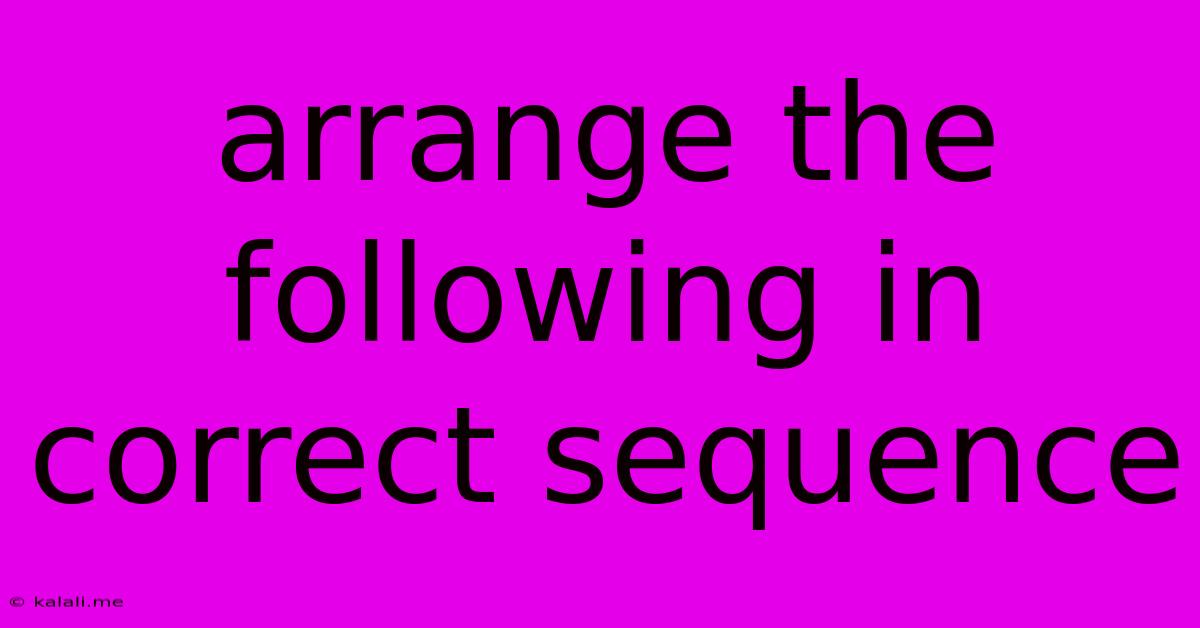Arrange The Following In Correct Sequence
Kalali
Jun 13, 2025 · 3 min read

Table of Contents
Arranging Items in the Correct Sequence: A Comprehensive Guide
This article provides a practical guide on how to effectively arrange items in the correct sequence, covering various scenarios and techniques. Whether you're ordering events chronologically, prioritizing tasks, or organizing data logically, understanding sequencing is crucial for clear communication and efficient problem-solving. This guide will equip you with strategies to master this essential skill.
Understanding Sequencing and its Importance
Sequencing, simply put, is the act of arranging items in a specific order. This order can be based on various factors, including time, importance, size, alphabetical order, or any other logical criterion. The correct sequence dramatically impacts clarity and understanding. Imagine a recipe with ingredients listed randomly – chaos! Or a historical account with events out of order – confusion reigns! Mastering sequencing is vital for tasks ranging from writing compelling narratives to managing complex projects.
Common Methods for Sequencing
Several methods facilitate efficient arrangement depending on the context:
1. Chronological Order: This is the simplest and most common method, arranging items based on their timeline. This is especially useful for:
- Narratives and Stories: Telling a story requires a chronological sequence to maintain coherence and reader engagement.
- Historical Accounts: Presenting events in the order they occurred is essential for accuracy and understanding.
- Process Descriptions: Explaining a procedure requires a step-by-step chronological approach.
2. Order of Importance: Prioritizing items based on their significance is crucial for effective task management and decision-making. Consider:
- Task Prioritization: Using methods like the Eisenhower Matrix (urgent/important) to organize tasks.
- Problem Solving: Identifying and addressing the most critical issues first.
- Argument Construction: Presenting supporting arguments in order of strength or relevance.
3. Spatial Order: Arranging items based on their physical location is essential for:
- Descriptions of Places: Describing a room or landscape requires a clear spatial order.
- Directions and Instructions: Giving directions or explaining assembly requires a clear spatial sequence.
- Mapping and Diagrams: Creating maps and diagrams necessitates a logical spatial arrangement.
4. Alphabetical Order: This simple method is frequently used for:
- Organizing Lists: Alphabetical order simplifies searching and finding specific items in a list.
- Bibliographies and References: Consistent alphabetical ordering is standard academic practice.
- Indexing: Alphabetical indexes allow for quick access to information within a document.
5. Numerical Order: Arranging items based on numerical value is useful for:
- Data Organization: Sorting numerical data, such as test scores or sales figures.
- Ranking and Rating: Presenting ranked lists or ratings.
- Sequential Numbering: Numbering items in a sequence for clarity and identification.
Tips for Effective Sequencing
- Clearly Define Your Criteria: Determine the basis for your sequencing (chronological, importance, etc.) before you begin.
- Break Down Complex Tasks: For large datasets or complex projects, break the task into smaller, manageable parts.
- Use Visual Aids: Flowcharts, timelines, or mind maps can help visualize the sequence and identify gaps or inconsistencies.
- Review and Revise: Always review your sequenced items to ensure logical flow and accuracy. A second pair of eyes can be invaluable.
- Consider Your Audience: Adapt your sequencing to your audience's understanding and expectations.
Conclusion
Mastering sequencing is a fundamental skill applicable across numerous contexts. By understanding different methods and employing effective strategies, you can improve clarity, efficiency, and the overall impact of your work, whether it's crafting a compelling narrative, managing a complex project, or simply organizing a to-do list. Practice these techniques, and you'll see a significant improvement in your ability to arrange items in the correct sequence.
Latest Posts
Latest Posts
-
Router Works At Which Layer Of Osi Model
Jun 14, 2025
-
What Is The Lightest Element In The Periodic Table
Jun 14, 2025
-
Compute The Mass Fractions Of Ferrite And Cementite In Pearlite
Jun 14, 2025
-
What Is The Factor Of 23
Jun 14, 2025
-
Johnson C Smith University Gpa Requirements
Jun 14, 2025
Related Post
Thank you for visiting our website which covers about Arrange The Following In Correct Sequence . We hope the information provided has been useful to you. Feel free to contact us if you have any questions or need further assistance. See you next time and don't miss to bookmark.